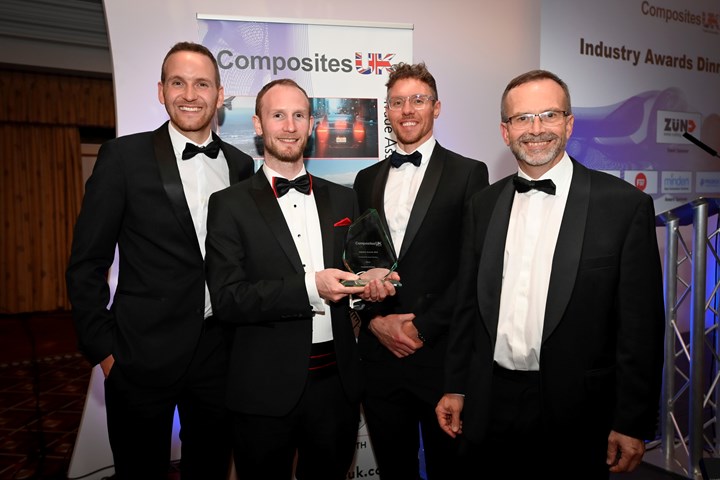Composite Braiding wins Composites UK Industry Award for sustainable composites innovation
Low-carbon manufacturing process for structural composites could help deliver decarbonization at scale while producing at high-volumes, low costs.
At a Nov. 2 awards dinner held in Birmingham, U.K., coinciding with the Advanced Engineering Show (AES), Composite Braiding Ltd. (Derby, U.K.), was announced as this year’s “Sustainability Award|Net-Zero” Composites UK Industry Award winner. The company developed a low-carbon manufacturing process for structural composites, which also enables higher production volumes and lower costs. The initiative was partly funded by an Innovate UK loan.
“We’re thrilled to have won another Composites UK award this year for our work to decarbonize composites manufacturing processes,” Steve Barbour, managing director of Composite Braiding, says. The company brought home an award under the “Innovation in Composite Materials” category in 2021. “It just goes to show what small companies can do, when you have an innovative team and funding behind you.”
The innovative manufacturing process “involves induction, but also brings some other proven technologies from outside the composites world and combines them in a new way,” Barbour explains. While unable to go into too much detail on the precise technology, he emphasizes the end result as a “very energy-efficient process, allowing for high part volumes,” as it can produce components in minutes rather than hours. The process is also reported to reduce energy consumption by up to 99%, compared to traditional processes, uses tooling that’s 50% lighter and is capable of reducing consumable waste.
Most fiber reinforcements (the company is using carbon, glass or basalt fibers) and matrices (polypropylene (PP), nylons (including bio-nylon PA11), PET, PPS and more) have been process-proven. Moreover, as the process is very controllable, Barbour notes that it should be capable of curing thermoset resins, though this has not been tested yet.
The versatile manufacturing process is capable of producing structural tubes, poles and beams for a wide range of applications, for diameters up to several hundred millimeters, and up to six meterss in length, though Barbour believes larger capabilities will be possible in the near future. Transportation, infrastructure and sports applications are the company’s initial focus, but with the “permanent antimicrobial material that we developed last year, we also see broad applications in the medical sector,” Barbour says.
“This is a game-changing capability,” he continues. “If this process is adopted by multiple users, which is our aim, it will help deliver decarbonization at scale. We are already talking to third parties about broadening the awareness and availability of our capabilities to multiple sectors.”
Related Content
-
CirculinQ: Glass fiber, recycled plastic turn paving into climate solutions
Durable, modular paving system from recycled composite filters, collects, infiltrates stormwater to reduce flooding and recharge local aquifers.
-
Recycling end-of-life composite parts: New methods, markets
From infrastructure solutions to consumer products, Polish recycler Anmet and Netherlands-based researchers are developing new methods for repurposing wind turbine blades and other composite parts.
-
Novel composite technology replaces welded joints in tubular structures
The Tree Composites TC-joint replaces traditional welding in jacket foundations for offshore wind turbine generator applications, advancing the world’s quest for fast, sustainable energy deployment.
















